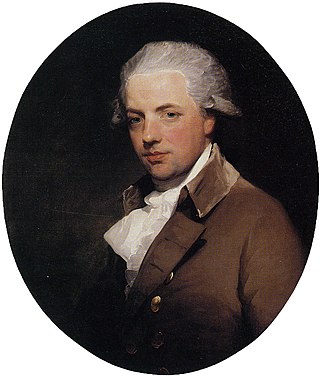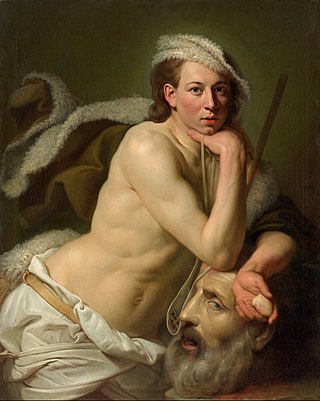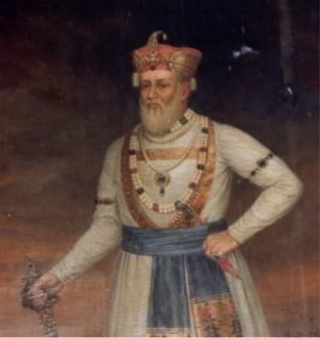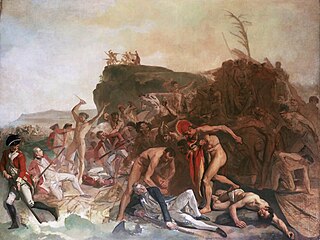
Awadh, known in British historical texts as Avadh or Oudh, is a historical region in northern India, now constituting the northeastern portion of Uttar Pradesh. It is roughly synonymous with the ancient Kosala region of Hindu, Buddhist, and Jain scriptures.

Ozias Humphry was a leading English painter of portrait miniatures, later oils and pastels, of the 18th century. He was elected to the Royal Academy in 1791, and in 1792 he was appointed Portrait Painter in Crayons to the King.

Faizabad is a city in Ayodhya district in the Indian state of Uttar Pradesh. Faizabad and the neighbouring city of Ayodhya are administered by Ayodhya Municipal Corporation. It was the headquarters of Faizabad district and Faizabad division. On 6 November 2018 the Uttar Pradesh cabinet headed by chief minister Yogi Adityanath approved the renaming of Faizabad district as Ayodhya district and Faizabad division as Ayodhya division. Faizabad is situated on southern the bank of the River Saryu about 130 km east of state capital Lucknow. It was the first capital of the Nawabs of Awadh and has monuments built by the Nawabs, like the Tomb of Bahu Begum, Gulab Bari.

Mirza Asaf-ud-Daula was the Nawab wazir of Oudh ratified by Shah Alam II, from 26 January 1775 to 21 September 1797, and the son of Shuja-ud-Dowlah. His mother and grandmother were the Begums of Oudh.

Major-General Claude Martin was a French army officer who served in the French and later British East India companies in colonial India. Martin rose to the rank of major-general in the British East India Company's Bengal Army. Martin was born in Lyon, France, into a humble background, and was a self-made man who left a substantial lasting legacy in the form of his writings, buildings and the educational institutions he founded posthumously. There are now ten schools named after him, two in Lucknow, two in Calcutta and six in Lyon. The small village of Martin Purwa in India was also named after him.

La Martinière Lyon is the La Martinière College branch in Lyon, France. Lyon hosts three La Martinière colleges, which were all created by Claude Martin: La Martinière Monplaisir, La Martinière Duchère, and La Martinière Terreaux.

Johan Joseph Zoffany was a German neoclassical painter who was active mainly in England, Italy and India. His works appear in many prominent British collections, including the National Gallery, the Tate Gallery and the Royal Collection, as well as institutions in continental Europe, India, the United States and Australia. His name is sometimes spelled Zoffani or Zauffelij.

The Tribuna of the Uffizi (1772–1778) by Johan Zoffany is a painting of the north-east section of the Tribuna room in the Uffizi in Florence, Italy. The painting is part of the United Kingdom's Royal Collection.
Martin Purwa, also known as Martinpurwa or Martinpura) is a neighbourhood of the city of Lucknow in the state of Uttar Pradesh, India. It is part of the Vikramaditya ward. Martin Purwa has a population of around 4,000. It is part of the La Martiniere College estate. Its previous name was 'Luckperra'.

Yameen-ud Daula Saadat Ali Khan II Bahadur was the sixth Nawab of Oudh from 21 January 1798 to 11 July 1814, and the son of Shuja-ud-Daula. He was of Persian origin.

Nawab Faizullah Ali Khan was the first Nawab of Rampur. The princely state of Rampur was set up in year 1774, after the First Rohilla War, by the dismemberment of the Rohilla Kingdom of Rohilkhand. Faizullah Khan, the only surviving heir of Ali Mohammed Khan and opponent of the forces of Awadh and the British East India Company in the war, was installed as ruler of what was the newly created Rampur State. It bordered the Maratha Empire to the south, making it a strategic point. Under tutelage of the East India Company, Faizullah Khan ruled peacefully for 20 years. The capital Rampur was founded, and the Raza Library collection gathered.

The Niccolini-Cowper Madonna, also known as the Large Cowper Madonna, is a painting by the Italian High Renaissance artist Raphael, depicting Mary and Child, against a blue sky.

Thomas Patch was an English painter, printmaker in etching, physiognomist and art historian. He made a living from painting views of Florence and Tivoli and appears to have sold a number of painted caricature groups to members of the Anglo-Florentine community and to young British men on the Grand Tour. The largest collection of his paintings and prints is in the Lewis Walpole Library in Farmington, Connecticut.

George Nassau Clavering-Cowper, 3rd Earl Cowper was an English peer who went on the Grand Tour as a young man, but actually emigrated. Despite becoming a member of parliament and later inheriting lands and the title of Earl Cowper in England, he remained in Italy. He amassed a valuable art collection and became a Prince of the Holy Roman Empire. He was a patron of the arts and science.

Other Hickman Windsor, 5th Earl of Plymouth FRS, styled Lord Windsor until 1771, was an English nobleman.

The Death of Captain James Cook, 14 February 1779 is a painting by Johann Zoffany. The painting records the loss of the British explorer Captain James Cook. The painting was made in around 1794 or 1795, some years after the death of Cook in 1779. Other paintings of the death of Cook were painted earlier. The Mahiole that was included in the painting of Cook's death by Zoffany is said to be the helmet given to Cook when he first landed in Hawaii.

Local tradition holds Fyzabad or now Faizabad is identical with the Saket of the Ramayana, supposedly the private estate of King Dasharatha, father of Lord Rama. It is claimed that Saket was renamed after the death of Faiz Baksh, a courtier of the Nawab of Awadh. Historically, when Nawab Saadat Ali Khan, Burhan-ul-Mulk was given the charge of the Subah of Awadh around 1722 by the Mughal court, he settled on the banks of the river Ghaghara, building a fortress and mud barracks. Due to these temporary dwellings, the settlement was initially referred to as 'Bangla'.

Felton Hervey was an aristocratic English politician from Bury St Edmunds in Suffolk, and a member of the British royal household. He took his son and daughter on a grand tour of Italy where he met Johann Zoffany and Pope Clement XIV.

Charles Loraine Smith or Charles Loraine was a sportsman, artist and politician. He inherited his family seat in Enderby, Leicestershire while still a boy. He was a keen horseman and his paintings of animals are well regarded. He painted both parodies and more serious subjects. He served in the British parliament, was mentioned in a divorce case, met the pope and rose to be a High Sheriff of Leicestershire.

The Oudh State was a princely state in the Awadh region of North India until its annexation by the British in 1856. The name Oudh, now obsolete, was once the anglicized name of the state, also written historically as Oudhe.




















